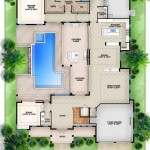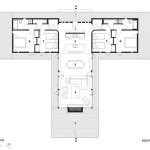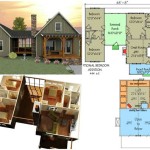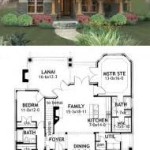A house plan with a courtyard is a type of residential design that incorporates an open-air, enclosed space within the home’s footprint. Courtyards serve as private outdoor oases, offering natural light, ventilation, and a sense of tranquility to the surrounding living areas. In traditional Arabic and Mediterranean architecture, courtyards have been a central feature, providing privacy, shade, and a place for socializing.
Modern house plans with courtyards have embraced this concept, adapting it to a wide range of architectural styles. Courtyards can be designed as intimate, secluded spaces or as larger, more open areas that connect to multiple rooms. They can be landscaped with plants, water features, and seating areas, creating a serene and inviting escape right at home.
In the following sections, we will delve into the benefits, design considerations, and inspirations for incorporating a courtyard into a house plan. We will explore how courtyards can enhance natural light, promote indoor-outdoor living, and create a sense of privacy and tranquility within the home.
A well-designed house plan with a courtyard offers numerous advantages, including:
- Enhanced natural light
- Improved ventilation
- Increased privacy
- Tranquil outdoor space
- Indoor-outdoor connection
- Architectural interest
- Added value
- Environmental benefits
- Historical significance
Courtyards can be customized to complement any architectural style and lifestyle, making them a versatile and desirable feature in modern home design.
Enhanced natural light
Courtyards act as natural light wells, channeling daylight deep into the home’s interior. By creating an open space within the floor plan, courtyards allow sunlight to penetrate from multiple angles, illuminating living areas and reducing the need for artificial lighting.
- Windows and doors facing the courtyard: Courtyards provide ample opportunities for windows and doors to face inward, maximizing the amount of natural light that enters the home. This not only brightens up the interior but also reduces energy consumption for lighting.
- Reflective surfaces: The walls and surfaces surrounding the courtyard can be painted in light colors or finished with reflective materials to bounce sunlight deeper into the home. This creates a brighter and more cheerful atmosphere within the living spaces.
- Skylights: If the courtyard is covered by a roof or canopy, skylights can be incorporated to allow natural light to filter in from above. This is particularly effective in areas with limited direct sunlight.
- Glazed walls and doors: Floor-to-ceiling windows and glass doors can be used to create a seamless transition between the courtyard and the interior, allowing natural light to flow freely throughout the home.
The enhanced natural light provided by a courtyard not only creates a brighter and more inviting living environment but also has numerous benefits for health and well-being. Natural light helps regulate circadian rhythms, improves mood, and reduces eyestrain.
Improved ventilation
Courtyards play a crucial role in improving ventilation within a home. By creating an open space in the center of the house, courtyards allow air to circulate freely, reducing the buildup of stale air and pollutants.
- Cross-ventilation: Courtyards facilitate cross-ventilation by allowing air to flow through the home from multiple directions. Openings on opposite sides of the courtyard, such as windows, doors, and vents, create a natural airflow that helps to cool and ventilate the living spaces.
- Stack effect: In taller buildings, courtyards can be used to create a stack effect. As warm air rises, it exits through openings at higher levels, drawing cooler air into the courtyard from below. This natural convection helps to keep the home ventilated and comfortable.
- Reduced moisture and humidity: Courtyards provide a well-ventilated space for moisture to escape from the home. This helps to reduce humidity levels, which can improve air quality and prevent the growth of mold and mildew.
- Improved indoor air quality: The increased ventilation provided by courtyards helps to dilute and remove indoor air pollutants, such as dust, dander, and VOCs (volatile organic compounds). This can improve air quality and create a healthier indoor environment.
Proper ventilation is essential for maintaining a comfortable and healthy living environment. Courtyards offer an effective and sustainable way to improve ventilation in homes, reducing the risk of respiratory problems, allergies, and other health issues.
Increased privacy
Courtyards offer increased privacy to homes by creating a physical and visual barrier from the outside world. This is especially beneficial for homes located in densely populated areas or on busy streets.
- Enclosed outdoor space: Courtyards are enclosed spaces, typically surrounded by walls or fences, which provides privacy from neighbors and passersby. This allows homeowners to enjoy their outdoor space without feeling exposed or overlooked.
- Reduced noise pollution: The enclosed nature of courtyards also helps to reduce noise pollution from outside sources. The walls and other structures surrounding the courtyard act as sound barriers, creating a more peaceful and serene outdoor environment.
- Concealed views: Courtyards can be designed to conceal views of the surrounding area, providing homeowners with privacy and seclusion. This can be achieved through strategic landscaping, the use of privacy screens, or the careful placement of walls and fences.
- Protection from prying eyes: The walls and other structures surrounding the courtyard create a physical barrier that prevents outsiders from looking directly into the home. This provides homeowners with peace of mind and a sense of security.
The increased privacy offered by courtyards makes them an ideal choice for homeowners who value their privacy and want to create a secluded outdoor haven.
Tranquil outdoor space
Courtyards offer a tranquil and serene outdoor space within the home, providing a sanctuary for relaxation, meditation, and entertainment.
- Escape from the hustle and bustle: Courtyards provide a private and secluded outdoor space where homeowners can escape from the hustle and bustle of everyday life. Surrounded by walls or fences, courtyards create a sense of peace and tranquility, allowing homeowners to unwind and recharge in their own private oasis.
- Connection with nature: Courtyards bring the outdoors in, creating a space where homeowners can connect with nature without leaving the comfort of their home. Landscaping with plants, flowers, and water features creates a sensory experience that soothes the mind and promotes relaxation.
- Meditation and mindfulness: The tranquil environment of a courtyard makes it an ideal space for meditation and mindfulness practices. The enclosed nature of the courtyard provides a sense of safety and privacy, allowing homeowners to focus on their inner thoughts and feelings.
- Outdoor entertaining: Courtyards can be designed to accommodate outdoor entertaining, providing a comfortable and inviting space for gatherings with family and friends. Covered patios, built-in seating, and outdoor kitchens make courtyards perfect for al fresco dining, barbecues, and other social events.
The tranquil outdoor space offered by courtyards enhances the quality of life for homeowners, providing a place to relax, recharge, and connect with nature and loved ones.
Indoor-outdoor connection
Courtyards foster a seamless connection between indoor and outdoor living spaces, blurring the boundaries between the two. This integration of nature into the home creates a more spacious, inviting, and healthy living environment.
- Extended living space: Courtyards extend the living space beyond the confines of the traditional home, providing an additional outdoor area that can be used for a variety of activities. This extra space can be used for dining, entertaining, relaxing, or simply enjoying the fresh air.
- Natural light and ventilation: Courtyards allow natural light to penetrate deep into the home’s interior, creating brighter and more inviting living spaces. The open design of courtyards also promotes natural ventilation, reducing the need for artificial lighting and air conditioning.
- Improved indoor air quality: The plants and greenery in courtyards help to improve indoor air quality by absorbing pollutants and releasing oxygen. This can create a healthier and more comfortable living environment for homeowners.
- Enhanced well-being: Studies have shown that spending time in nature can have a positive impact on mental and physical well-being. Courtyards provide a private and convenient way to connect with nature, reducing stress, improving mood, and boosting overall health.
The indoor-outdoor connection offered by courtyards creates a more livable and enjoyable home environment, enhancing the quality of life for homeowners and their families.
Architectural interest
Courtyards add significant architectural interest to homes, creating visually appealing and distinctive designs. The enclosed nature of courtyards allows for unique architectural elements and features that would not be possible in traditional open-plan homes.
One of the key architectural benefits of courtyards is the ability to create multiple focal points within the home. The courtyard itself becomes a central feature, drawing the eye and creating a sense of depth and dimension. Surrounding the courtyard, windows, doors, and balconies can be arranged to frame the courtyard and create a harmonious relationship between indoor and outdoor spaces.
Courtyards also provide opportunities for creative landscaping and hardscaping. Plants, trees, water features, and sculptures can be used to create a serene and inviting outdoor space that complements the architectural style of the home. The vertical surfaces surrounding the courtyard, such as walls and fences, can be adorned with decorative elements, artwork, or lighting to further enhance the visual appeal.
In addition to their aesthetic value, courtyards can also serve functional purposes. They can be designed to provide privacy, reduce noise pollution, and improve natural ventilation. By incorporating courtyards into their designs, architects can create homes that are not only visually stunning but also practical and comfortable.
The architectural interest offered by courtyards makes them a popular choice for homeowners who want to create a unique and stylish home that stands out from the ordinary.
Added value
In addition to the numerous benefits they offer in terms of natural light, ventilation, privacy, and indoor-outdoor living, courtyards can also add significant value to a home.
- Increased property value: Homes with courtyards are generally more desirable and command a higher resale value compared to similar homes without courtyards. This is because courtyards are seen as a valuable amenity that enhances the overall quality of life for homeowners.
- Increased rental income: For homeowners who rent out their properties, courtyards can be a key differentiator that attracts tenants and allows them to charge higher rent. Tenants value the privacy, outdoor space, and natural light that courtyards provide.
- Reduced energy costs: The natural light and ventilation provided by courtyards can reduce the need for artificial lighting and air conditioning, leading to lower energy costs for homeowners.
- Improved curb appeal: Courtyards can significantly enhance the curb appeal of a home, making it more attractive to potential buyers or tenants. The enclosed outdoor space and unique architectural features of courtyards create a visually appealing and inviting exterior.
The added value that courtyards provide makes them a worthwhile investment for homeowners who are looking to increase the value, desirability, and enjoyment of their homes.
Environmental benefits
Courtyards offer several environmental benefits that contribute to a more sustainable and eco-friendly home environment.
- Reduced energy consumption: Courtyards can help to reduce energy consumption in several ways. The natural light provided by courtyards reduces the need for artificial lighting during the day. Additionally, the thermal mass of the walls and other structures surrounding the courtyard can help to regulate indoor temperatures, reducing the need for heating and cooling.
- Improved air quality: Courtyards can help to improve air quality by providing a space for plants and greenery. Plants absorb carbon dioxide and release oxygen, which can help to purify the air inside the home. Additionally, courtyards can help to reduce air pollution by filtering out dust and other particles from the outdoor air.
- Water conservation: Courtyards can be designed to incorporate rainwater harvesting systems. Rainwater can be collected from the roof and stored in a cistern for later use in irrigation or other non-potable purposes. This can help to reduce the demand for municipal water.
- Reduced urban heat island effect: Courtyards can help to reduce the urban heat island effect by providing green space and shade. The trees and plants in courtyards absorb sunlight and release water vapor through transpiration, which can help to cool the surrounding area.
By incorporating courtyards into their designs, homeowners can create homes that are not only comfortable and stylish but also environmentally friendly and sustainable.
Historical significance
Courtyards have a rich historical significance, dating back to ancient times. They have been an integral part of residential architecture in various cultures around the world, serving both functional and aesthetic purposes.
- Ancient Egypt: Courtyards were a common feature in ancient Egyptian homes, providing natural light, ventilation, and privacy. The courtyards were often surrounded by columns and adorned with water features, creating aasis-like retreat from the hot and dry climate.
- Roman Empire: Roman houses often featured courtyards, known as atriums. The atrium was the central gathering space of the home, serving as a place for cooking, dining, and socializing. The atrium was typically open to the sky, allowing for natural light and ventilation.
- Islamic Architecture: Courtyards played a crucial role in Islamic architecture, particularly in the design of mosques and palaces. The courtyard provided a private and secluded space for prayer and contemplation. Islamic courtyards were often elaborately decorated with fountains, gardens, and intricate tilework.
- Traditional Chinese Architecture: Courtyards have been an essential element of traditional Chinese architecture for centuries. The courtyard, known as siheyuan, is the central organizing space of the home. It is surrounded by buildings on all four sides and typically features a garden or water feature.
The historical significance of courtyards demonstrates their enduring appeal and adaptability. They have been a vital part of residential design for millennia, providing natural light, ventilation, privacy, and a connection to nature. Today, courtyards continue to be a popular feature in modern architecture, offering a timeless and functional design element.










Related Posts








